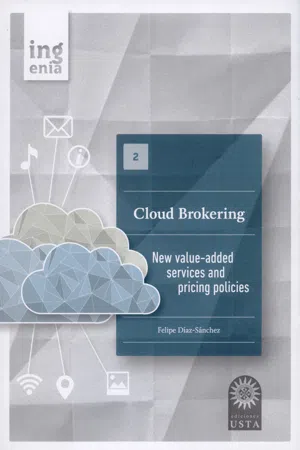
- English
- ePUB (mobile friendly)
- Available on iOS & Android
Cloud Brokering
About this book
El servicio de intermediación en la nube es un paradigma de servicio que proporciona interoperabilidad y portabilidad de aplicaciones a través de múltiples proveedores de nube. El atractivo de la intermediación en la nube depende de los nuevos servicios y de las instalaciones informáticas ampliadas que mejoran o complementan los ya ofrecidos por los proveedores de nube aislados. Estos servicios brindan un nuevo valor a las pequeñas y medianas empresas (PYMES) y grandes empresas y hacen que los proveedores de nube sean más competitivos. Hoy en día, a nivel de infraestructura, los intermediarios de servicios en la nube actúan como intermediarios entre los usuarios finales y los proveedores de nube. El intermediario de servicios en la nube proporciona un punto único para el consumo de servicios con el fin de evitar el bloqueo del proveedor, aumentar la resiliencia de las aplicaciones, proporcionar facturación unificada y simplificar los procesos de gobernanza, adquisición y liquidación a través de múltiples proveedores en la nube. En el futuro, los intermediarios de servicios en la nube ofrecerán servicios avanzados de valor agregado y usarán modelos de precios atractivos para capturar a posibles consumidores de nube. La finalidad este libro es proponer servicios avanzados de valor agregado y un modelo de precios para los intermediarios de servicios en la nube. Este libro tiene tres objetivos: • El primero es presentar una figura única de mérito del rendimiento de las máquinas virtuales de la nube basado en el perfil de aplicación. • El segundo es proponer un enfoque exacto para la asignación de máquinas virtuales a través de múltiples proveedores de nube con base en diferentes criterios de optimización. • El tercero es describir el modelo de precios para la intermediación de servicios en la nube, llamado payasyoubook.
Frequently asked questions
- Essential is ideal for learners and professionals who enjoy exploring a wide range of subjects. Access the Essential Library with 800,000+ trusted titles and best-sellers across business, personal growth, and the humanities. Includes unlimited reading time and Standard Read Aloud voice.
- Complete: Perfect for advanced learners and researchers needing full, unrestricted access. Unlock 1.4M+ books across hundreds of subjects, including academic and specialized titles. The Complete Plan also includes advanced features like Premium Read Aloud and Research Assistant.
Please note we cannot support devices running on iOS 13 and Android 7 or earlier. Learn more about using the app.
Information
- 50% of the relevant studies investigated applying cloud computing to scientific issues, while only 16% of the studies focused on the evaluation of business applications in the cloud.
- 21 cloud services over 9 cloud providers were identified. 70% of the relevant studies evaluated cloud services provided by Amazon Web Services (AWS).
- Three main aspects and their properties for cloud services evaluation have been investigated (performance, economics and security), performance being the most studied aspect (78 studies).
- There is no consensus regarding the definition and the usage context of metrics. Some metrics with the same name were used for different purposes, some metrics with different names were essentially the same. The study identified more than 500 metrics including duplications.
- There is a lack of effective metrics vis-à-vis elasticity and security aspects in cloud computing. Therefore, it is hard to quantify these aspects.
- There is not a single or a small set of benchmarks that provides a holistic evaluation of cloud services. The SLR identified around 90 different benchmarks in the selected studies of cloud services evaluation. These benchmarks can be grouped in three main categories: application, synthetic and micro-benchmarks, as explained below.
- 25 basic setup scenarios for constructing complete cloud service evaluation experiments have been identified and classified.
- The cloud service evaluation is getting more and more attention from the research community. The number of relevant studies was 17 times larger in 2011 (34 studies) than in 2007 (2 studies).
Table of contents
- Portada
- Título
- Derechos de autor
- About this book
- Cloud brokering
- Part I. Value-added services in cloud brokering
- Part II. A new pricing model in cloud brokering
- Conclusion and future works
- Appendix A. Studies related to cloud providers performance
- Appendix B. Cloud performance evaluation: details and extended results
- Bibliography